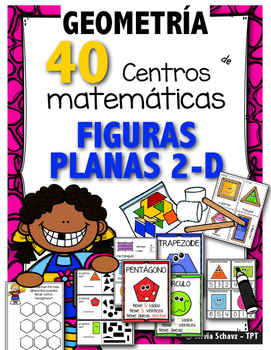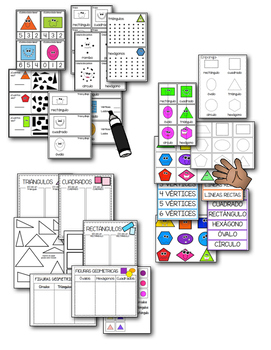40 Centros de aprendizaje de geometría (FIGURAS PLANAS) para Kindergarten
Silvia Schavz
8.5k Followers
Grade Levels
PreK - 1st, Homeschool
Subjects
Resource Type
Standards
CCSSK.G.A.2
CCSSK.G.A.3
CCSSK.G.B.4
CCSSK.G.B.5
CCSSK.G.B.6
Formats Included
- PDF
Pages
100 pages
Silvia Schavz
8.5k Followers
What educators are saying
A mis alumnos de jardín de infantes les encantaron las actividades de este recurso. Muchas gracias por compartir sus ideas en este producto.
My kindergarten students loved the activities in this resource. Thank you very much for sharing your ideas in this product.
Description
This enormous file contains 40 engaging geometry learning centers to learn 2-D shapes in pre school and kindergarten. There are enough centers for a whole class! The variety and beautiful graphics will motivate your students to “play” the games.
INCLUDES NINE POSTERS FOR YOUR CLASSROOM!
These learning centers help the students to practice:
CCSS.MATH.CONTENT.K.G.A.2
Correctly name shapes regardless of their orientations or overall size.
CCSS.MATH.CONTENT.K.G.A.3
Identify 2 - D shapes
CCSS.MATH.CONTENT.K.G.B.4
Analyze and compare two dimensional shapes, in different sizes and orientations, using informal language to describe their similarities, differences, parts (e.g., number of sides and vertices/"corners") and other attributes (e.g., having sides of equal length).
CCSS.MATH.CONTENT.K.G.B.5
Model shapes in the world by building shapes from components (e.g., sticks and clay balls) and drawing shapes.
CCSS.MATH.CONTENT.K.G.B.6
Compose simple shapes to form larger shapes. For example, "Can you join these two triangles with full sides touching to make a rectangle?"
IF YOU HAVE KINDERGARTEN STUDENTS WHO HAVE NEVER BEING EXPOSED TO NUMBERS, I HAVE THE PERFECT RESOURCE FOR THEM: 35 Centros básicos de aprendizaje de matemáticas para estudiantes sin experiencia. I also have 35 Centros básicos de aprendizaje para el inicio de kinder.
INCLUDES NINE POSTERS FOR YOUR CLASSROOM!
These learning centers help the students to practice:
CCSS.MATH.CONTENT.K.G.A.2
Correctly name shapes regardless of their orientations or overall size.
CCSS.MATH.CONTENT.K.G.A.3
Identify 2 - D shapes
CCSS.MATH.CONTENT.K.G.B.4
Analyze and compare two dimensional shapes, in different sizes and orientations, using informal language to describe their similarities, differences, parts (e.g., number of sides and vertices/"corners") and other attributes (e.g., having sides of equal length).
CCSS.MATH.CONTENT.K.G.B.5
Model shapes in the world by building shapes from components (e.g., sticks and clay balls) and drawing shapes.
CCSS.MATH.CONTENT.K.G.B.6
Compose simple shapes to form larger shapes. For example, "Can you join these two triangles with full sides touching to make a rectangle?"
IF YOU HAVE KINDERGARTEN STUDENTS WHO HAVE NEVER BEING EXPOSED TO NUMBERS, I HAVE THE PERFECT RESOURCE FOR THEM: 35 Centros básicos de aprendizaje de matemáticas para estudiantes sin experiencia. I also have 35 Centros básicos de aprendizaje para el inicio de kinder.
Total Pages
100 pages
Answer Key
N/A
Teaching Duration
N/A
Report this resource to TPT
Reported resources will be reviewed by our team. Report this resource to let us know if this resource violates TPT’s content guidelines.
Standards
to see state-specific standards (only available in the US).
CCSSK.G.A.2
Correctly name shapes regardless of their orientations or overall size.
CCSSK.G.A.3
Identify shapes as two-dimensional (lying in a plane, “flat”) or three-dimensional (“solid”).
CCSSK.G.B.4
Analyze and compare two- and three-dimensional shapes, in different sizes and orientations, using informal language to describe their similarities, differences, parts (e.g., number of sides and vertices/“corners”) and other attributes (e.g., having sides of equal length).
CCSSK.G.B.5
Model shapes in the world by building shapes from components (e.g., sticks and clay balls) and drawing shapes.
CCSSK.G.B.6
Compose simple shapes to form larger shapes. For example, “Can you join these two triangles with full sides touching to make a rectangle?”





